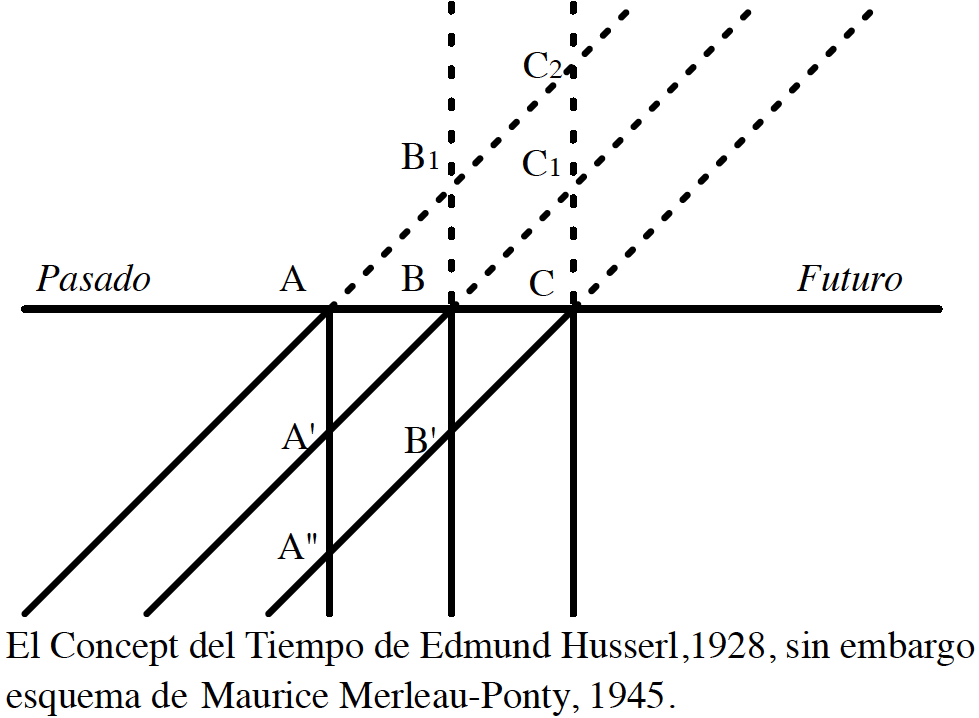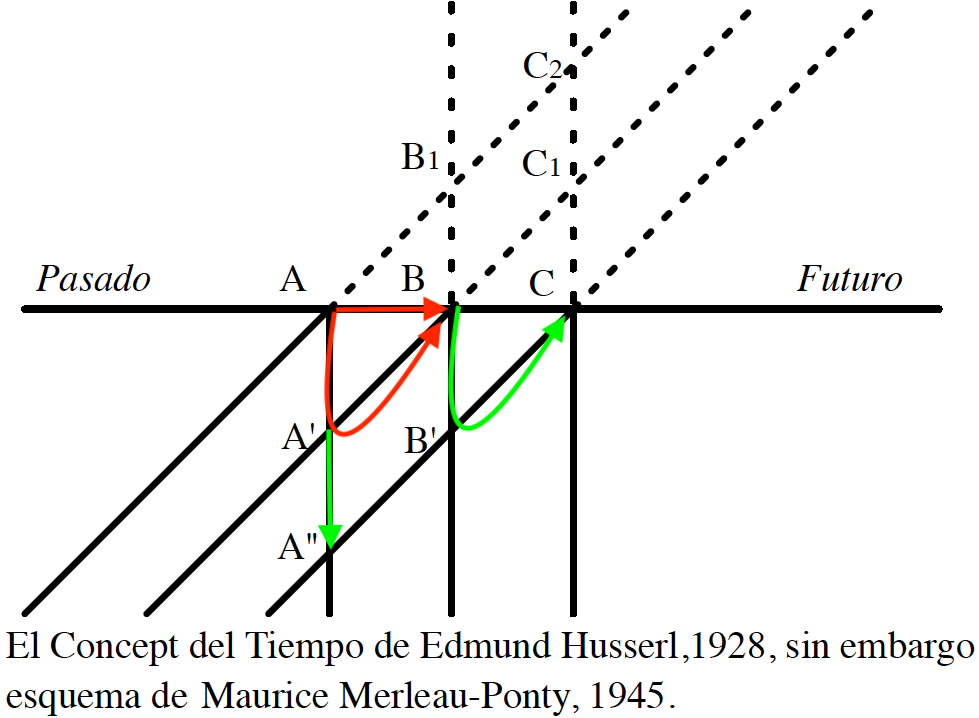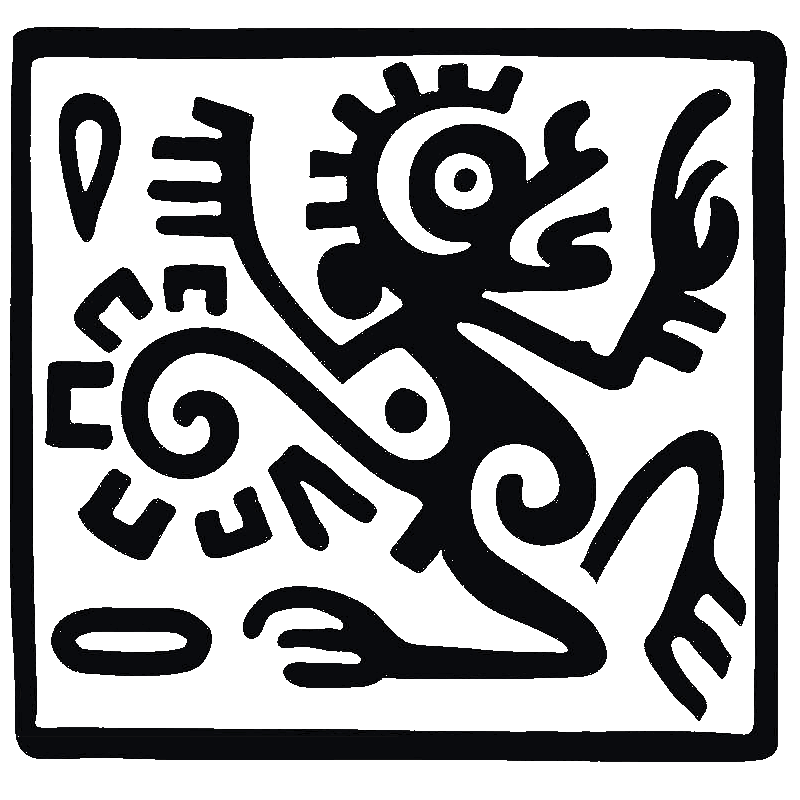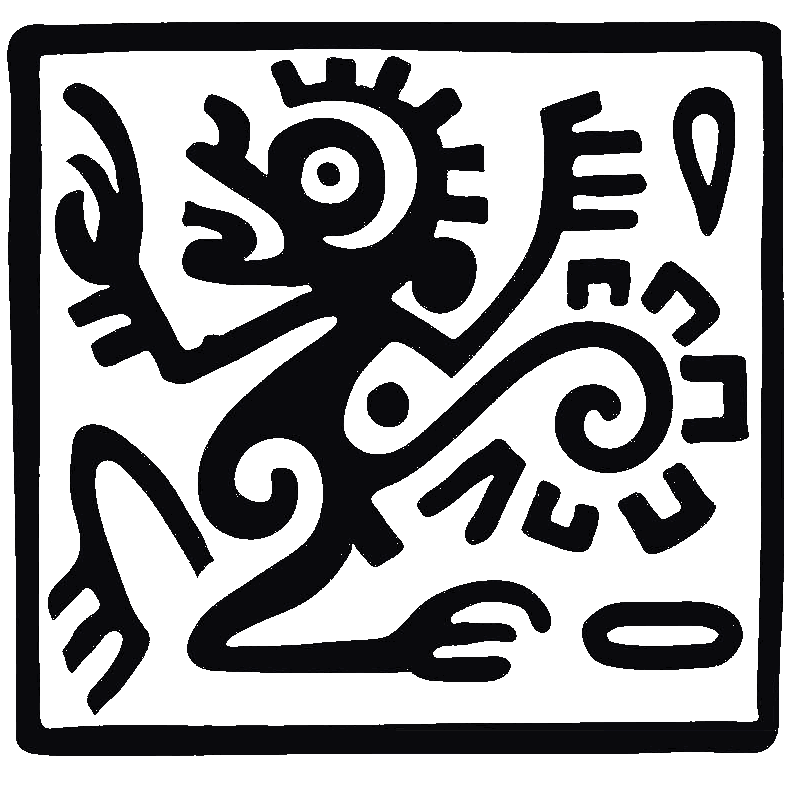The concept of time in phenomenology, inherited from Husserl's concept of time and explained by Merleau-Ponty, and forged by Lyotard
![]()
現象学における時間概念
The concept of time in phenomenology, inherited from Husserl's concept of time and explained by Merleau-Ponty, and forged by Lyotard
![]()
メルロ=ポンティはフッサールの遺稿を研究する中で,フッサールの研究は,その進化の過程で,ノエシス-ノエマ相関とは同化できない現象を浮かび上がらせていると指摘する。それ(=同化できない現象)が身体、主観的時間、そして他者だった。ノエシスとノエマとは、ノエシス=「思考の行為」であり、ノエマ=「思考の意図的対象」のことである。ノエシス-ノエマ相関とは、すなわち、思考すること(=行為すること)は、つねに思考の意図的対象を包含するということである。
メルロ=ポンティ(『知覚の現象学』)は言 う。時間は一本の線ではなく、もろもろの志向性 (インテンショナリティ)からなる網状の組織であ る、と。AからBに移る時は、A’を経由して、いまBへの移行を果たしたが、Aという時間意識をA’というかたちでもっているのである。BがCになると き、BはB’を経由してCへの移行を果たした。それと同時にA'はA"に〈落ちて〉いる。このようにして〈私の時間全体が動く〉のである。時間の相Bから Cに移行する時、未来のおこるべきものとして用意されていたC1はそこの位置からCに〈降りる〉のである。


ここでは現れていないDは、私がDの時相に移行する
時、Cは〈もはやない〉のである。そのようにしてリオタールは次のように言う。「もろもろの体験からな
る系列をあとから統一することについての真の問題は存在しない」と(リオタール1965:118)。
ただし、上の図は、リオタール(1965:117)に現れたものであり、メルロ=ポンティ『知覚の現象学』(翻訳第2巻:316ページ/中島訳, p.689)には、フッサー
ルの『内的時間意識の現象学』(訳書?22ページ/ Zeitbewusstain , p.22.)からの引用とし、上掲の図の実線の部分しかない。リオタールが、破線の部分を加筆して表現した可能性が
ある。
肝心のフッサールの講義録(ハイデガーが編集し た) Edmund Husserl, Vorlesungen zur Phänomenologie des inneren Zeitbewusstseins, 1928 には、メルロポンティの図も登場せず下記のような2つの作図が、それぞれ、389ページと446ページにそれぞれ登場するのみである(出典は:http: //www.freidok.uni-freiburg.de/volltexte/5974/ にリンクするpdfを参照)


さて、このような時間論を展開したからと言っ て、時間は不可逆名な線形の流れとしてではなく、メルロ=ポンティのいうような網状の組織として【のみ】で、代替的に理解してよいのだろうか? 少なくと も(数学や自然科学に通暁していた)フッサールにしても、それを引き継いだメルロ=ポンティにしても、さらには、より、この図式を洗練させて紹介したリオ タールにしても、残念——私は幸運と言いたいが——ながら時間のまず常識的理解、つまり近代的な生活世界の概念からは、やはりリニア(線形)な過去から未 来への進行(P→F)というメタファーを前提として、それだけではない、多層的な時間——たとえば現在になりつつある過去——のあり方を示すことで、リニ アな時間概念に厚みを加えた——認識論的な改良を加えた——とも言えるからである。
++++++++++++++++++++++++++++++++++++++++++++++++
O--E 今点たちの系列
O--E' 沈下する
E--E' 位相連続体(過去地平をともなった今点)
E → 他の諸客観でもって充実化されることもある今の系列
++++++++++++++++++++++++++++++++++++++++++++++++
■時間を空間的秩序に係留しない概念化
■エヴァンズ=プリチャードが表現する、ヌアー人(ヌ エル人)の時間概念化についての報 告にみられる。
「年間のサイクルを超えて、時間計測をすることは、 社会構造のあるひとつの概念化であり、(そこで)参照にされる諸時点は、人間のあいだの現実の関係の過 去の中に投影されている」
"Beyond the annual cycle, time-reckoning is a conceptualisation of the social structure, and the points for reference are a projection into the past of actual relationship between persons"(Evans-Pritchard 1950:108, cited in Douglas 1980).
「時間は連続体なのではない、そうではなく(時間 の)2つの時点の間の継続する構造的関係なのであり、その2つとは、父系出自における最初と最後の人間の ことなのだ」
"Time is not a continuum, but is a constant structurel relationship between two points, the first and last persons in a line of agnatic descent"(Evans-Pritchard 1950:108, cited in Douglas 1980).
"The oecological cycle is a year. Its distinctive rhythm is the backwards and forwards movement from villages to camps, which is the Nuer's response to the climatic dichotomy of rains and drought … [while] social structure time is a relation between a man and the social activities which relate men structurally to one and another" (Evans-Pritchard 1939: 189-192).
"Nuer have no abstract numerical system of time-reckoning based on astronomical observations but only descriptive divisions of cycles of human activities … since the months are anchored to oecological and social process the calendar is a conceptual schema which enables Nuer to view the year as an ordered succession of changes and to calculate to some extent the relation between one event and another in abstract numerical symbols" (Evans-Pritchard 1939:197, 200).
ここでの引用文献
■アルフレッド・シュッツの時間概念
Al pensar en mi amigo ausente A., me forjo un tipo ideal de su personalidad y conducta basado en mi pasada experiencia de A. como asociado mío. El echar una carta a un buzón, espero que personas desconocidas llamadas empleados de correo se conduzcan de modo típico, no del todo inteligible para mí, para que mi carta llegue a su destino dentro de un tiempo típicamente razonable. Sin haber conocido nunca a un francés y un alemán. entiendo "por qué Francia teme el rearme de Alemania" Obedeciendo a las reglas de la gramática inglesa [en mis escritos], adopto un esquema de conducta socialmente aprobado por mis semejantes contemporáneos angloparlantes a quienes debo ajustarme para hacerme comprender. y por último. todo artefacto o utensilio se refiere al anónimo semejante que lo fabricó para que fuera usado por otros anónimos semejantes a fin de alcanzar típicas metas por típicos medios. Estos son sólo unos pocos ejemplos que están sin embargo dispuestos de conformidad con el grado de creciente anonimato y. por lo tanto, de interpretación necesaria para captar al otro y su conducta. [The Problem of Social Reality, Collected Papers, 1, ed. M. Natanson (La Haya, 1962). [Hay traducción española: El problema de la realidad social , Buenos Aires, Amorronu, 1974.]., págs. 17-18.
■フランケンシュタインの物語の時間構造(図式)
A. 隊長ロバートは北極点探検の途上でヴィクター・フランケンシュタインを発見。フランケンシュタインは自分の体験を語る。
B. スイスの名家の青年フランケンシュタインはドイツの大学で自然科学を学ぶ。生命の謎を解き明かし、生命を自在にしたいと野心をもつ。
C. 理想の人間の設計図を完成させ、墓を暴き、人間の死体をつなぎ合わせ、11月に怪物の創造に成功する。
D. 怪物は優れた体力、心、知性をもつが、容貌が怪異で、フランケンシュタインは絶望をあまり怪物を残したまま、スイスに戻る。
E. 怪物は生き延び山野を越えてフランケンシュタインのもとに戻る。孤独な怪物は孤独を癒すために伴侶を創造するようにフランケンシュタインに要求し、二度と 彼のもとに戻らないことを約束する。
F. フランケンシュタインはそれを拒絶するが、怒った怪物は、復讐心に燃えた怪物派友人達を次々と殺害する。フランケンシュタインは怪物を追いかけ北極海にま で到達する。
G. 怪物を殺すようにロバートに語った後、フランケンシュタインは船上で息絶える。彼の遺体を残したあと、探検隊は北極点到達を断念し、帰途につこうとする が、そこに怪物が現れる。
H . フランケンシュタインの遺体を前に怪物は嘆き、みずからを焼いて死ぬために北極海に消える。怪物の消息は不明である。
これらをまとめると



フランケンシュタインの花嫁より
クレジット:現象学における時間概念:フッサールの時間概念を継承してメルロ=ポンティが解説し、リオタールが鍛えた…
■文献
リンク集(あまりレベルの高い高尚なものではな い)
その他の情報
Do not paste, but [re]think this message for all undergraduate students!!!


